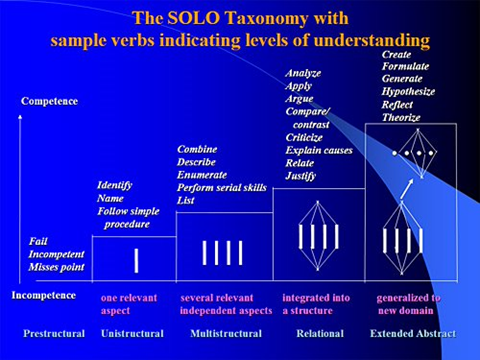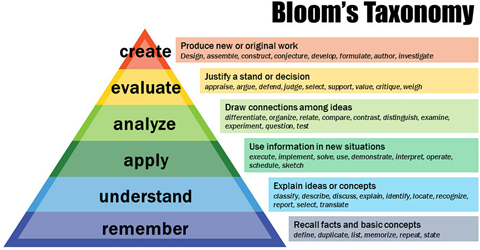Written response questions require an extended answer from students.
These questions often address higher order thinking skills and require students to recall or research information and apply that information in different ways.
Questions that require a longer response often require students to utilise higher order thinking skills and relate their knowledge to different contexts. Bloom’s Taxonomy and SOLO Taxonomy are two underlying frameworks that support this.
SOLO Taxonomy demonstrates five stages of learning where students develop more complex and integrated ideas and can apply concepts in new contexts the further along students are in their learning.

Image: Biggs, J., (1982) The SOLO Taxonomy. John Biggs https://www.johnbiggs.com.au/academic/solo-taxonomy/
Written response questions relate to the fourth and fifth elements of the SOLO Taxonomy – relational, where students apply knowledge for a purpose and extended abstract and explore new ways and avenues of applying knowledge.
Blooms Taxonomy is a framework comprising six learning domains, categorised by the level of thinking skills they require. Knowledge and comprehension involve lower order thinking and are typically addressed using other assessment methods, whereas higher skills such as application, analysis, evaluation and synthesis are well suited to an extended response.

Image: Scholarly Community Encyclopedia (2022) Bloom’s Taxonomy Visual Guide https://encyclopedia.pub/entry/30767

Select the content and subject learning outcomes you are assessing. Are there certain skills that need to be addressed? Have students been assessed at a lower level on this content previously?
Think about what you would like the students to produce. Think about; the length of the response, the time available to complete the question, how you would like students to respond (verbal, written, video, etc.), what type of text students are to produce, the intended audience (supervisor, potential client, peers, etc.) and academic integrity. Make sure to consider the marking workload in this step.
Consider how the students will complete the assessment. Think about: ideal steps/process, how to state clear and explicit instructions and avoid ambiguous terms and intimidating terminology.
Consider what the desired product is. Think about: what you would expect to see in terms of structure, content, and language, how to make marking criteria clear and obvious for students and graders and develop opportunities to show and work through exemplars with students.
Upon completion, review the process and results. Use any insights learned to refine your assessment design. Ensure to receive feedback from all involved in the process – markers and students can provide a unique point of view that you may not have considered.
Below is an example of an extended written response question.
This example question uses elements that support academic integrity against generative AI generators by
See below how this example was created through the five-step process:
In PowerPoint format:
Extended written response questions worked example
In H5P format:
Boud, D. and Associates (2010). Assessment 2020: Seven propositions for assessment reform in higher education. Sydney: Australian Learning and Teaching Council.